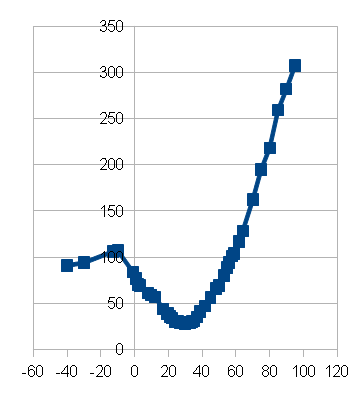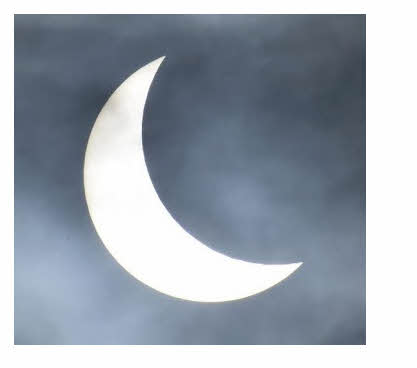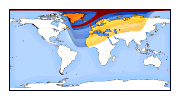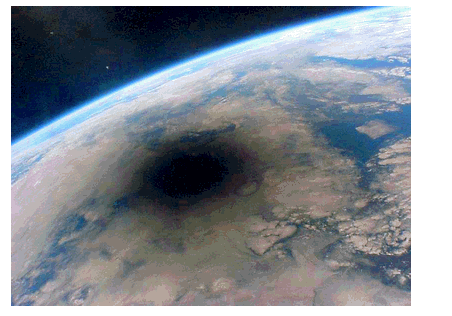
This is one of the Flat Earth Academy's "you might find interesting" pages. There is nothing here you "ought" to "know".
We had clouds on the day ... :-( But not all was not lost!!!
These observations from southern England, from about the same longitude as London.
The eclipse lasted, according the almanac, from 8:24 to 10:40
Here is a graph of the light intensity from 8:20 to well after the eclipse. The units for the vertical scale are non standard, The units of the horizontal scale are minutes-from-9am, UK time. The eclipse was most complete at 9:31 where I was, and the graph seems to support my hope that all of what I was seeing in light intensity arose from the eclipse.
I could kick myself for forgetting until 8:20 that I had the sensor I used! And for taking until the morning of the 20th to finally get around to writing the software to read it automatically. (I had to do it by hand for over half of the eclipse, but a crude version of the program, long overdue, is finally done... thank you, eclipse!)

I think you can clearly see the progressive drop in light levels, with the nadir at the right time, literally. Discussion of the interesting pattern at the left to come.
It would seem that although we had clouds, at least they remained fairly consistently translucent throughout the event.
How the data was collected. You could do something similar, but I have to warn you... there are a few "ingredients" to assemble.
First you need something with sensors which can serve web-pages. An Arduino is ideal. An Arduino "just" on a LAN will do.
Then you need to arrange for a line to appear in the page served by the Arduino, with the data from the sensors in a specific format.
Once you've got that, "only" that, the rest is easy! I am giving away the program which goes to the web server, fetches the page, extracts the data, and gives you a CSV file. (There are links from there to the "how to set up the Arduino" part.)
PLEASE... if you go and look, and think "that would be fun", even if you don't have time to try it yourself, spread the word? Making all of that (and this page, for that matter) was a lot of work. I begin to wonder if I should bother, given the amount of traffic that I get. But you've read this far... you must have enjoyed it at least a little bit. PLEASE TELL OTHERS! Facebook "like", mention....
https://flat-earth-academy.com/sci/astro/eclipse2015320.htm
... in a blog post. SOMETHING?
Here's another graph which may amuse. I THINK it shows a dip in the temperature during the event... but must admit that the dip isn't very pronounced!...

The red line is temperature. It ends about noon on the 20th, the day of the eclipse. The gray vertical lines are midnights, so we are seeing three full days, and part of the 20th and part of the 16th... you can see "normal" daily temperature swings on the first two full days. On the 19th, there was overcast, which usually, as here, acts like a "blanket"- keeping the sun's warmth away, if it is "pulled over us" in the late hours of the night (early hours of the pre-dawn!), as appears to have happened here. (If the cloud cover develops after a warm morning, and lasts through to the next dawn, the "blanket" of clouds keeps the earth warmer than it would become on a clear night.)
How THAT data was collected is explained on a page explaining my DS025 premise monitoring software.

The image on the left came from a page run byThe Guardian, which was the best I could find for live updates. Somehow, it seemed to me that to watch the eclipse on TV would have diminished it for me. Maybe I'm just weird. But I saw that image only minutes after it was taken, and it was consolation for not seeing (directly!) the same thing myself, and felt "real".
The photo was, thank you, by Toby Melville, and taken near Bridgewater, west of me, where I have very good friends. Taken at 9:17 local time. Sadly they didn't see it. It was also glimpsed in Brighton, east of me. And, wouldn't you know it, the skies were I was had only broken clouds by 11:30. Oh well.
I had the very good fortune when about 11 to see a total eclipse, in good weather. Very memorable, of course. (Even with good weather, for the March 2015 eclipse, where I was it would have been partial.)
The BBC "Stargazing Live" programme, hosted by Brian Cox and Dara O'Briain did a splendid job for astro-geeks and lay person alike, I thought. There's still a good web-page, and I suspect that the programmes are available via iPlayer, at least for a while.
The nice people at the Goddard Space Labs did some great, and not "ordinary" visualizations, which you can see, with narration, in this 60 second clip at YouTube..
Classic FM told me that there have been 8 total eclipses in the UK (England?) in 500 years. Roll on 2090, when we can see another one... in the UK.

If you don't mind a bit of travel, there's a nice one in South East Asia, March, 2016. That came from www.TimeAndDate.com/eclipse, where I think they lay everything out extremely well. There's a great lunar eclipse for western Europe and eastern North America, 28 September 2015, by the way. The little image on the right is TimeAndDate's presentation of the March 2015 solar eclipse.

I find the image on the right a little unsettling... almost looks like Gaia has a spot of necrosis? I'm not sure that this was of the March 2015 eclipse, but I don't imagine one (of equal "totality") would look much different from another, do you?
I hope the material above amused? If it did, you might also enjoy my account of seeing the 2012 transit of Venus. The sun's light didn't fall as much(!), but transits of Venus are more rare, and at least I did see this one directly... just.
Search across all my sites with the Google search button at the top of the page the link will take you to.
Or...
|
|||
| search engine by freefind |
The search engine merely looks for the words you type, so....
I have other sites. My Google custom search button will include things from them....
One of my SheepdogGuides pages.
My site at Arunet.
This page's editor, Tom Boyd, will be pleased if you get in touch by email.
![]() Page has been tested for compliance with INDUSTRY (not MS-only) standards, using the free, publicly accessible validator at validator.w3.org. It passes in some important ways, but still needs work to fully meet HTML 5 expectations. (If your browser hides your history, you may have to put the page's URL into the validator by hand. Check what page the validator looked at before becoming alarmed by a "not found" or "wrong doctype".)
Page has been tested for compliance with INDUSTRY (not MS-only) standards, using the free, publicly accessible validator at validator.w3.org. It passes in some important ways, but still needs work to fully meet HTML 5 expectations. (If your browser hides your history, you may have to put the page's URL into the validator by hand. Check what page the validator looked at before becoming alarmed by a "not found" or "wrong doctype".)